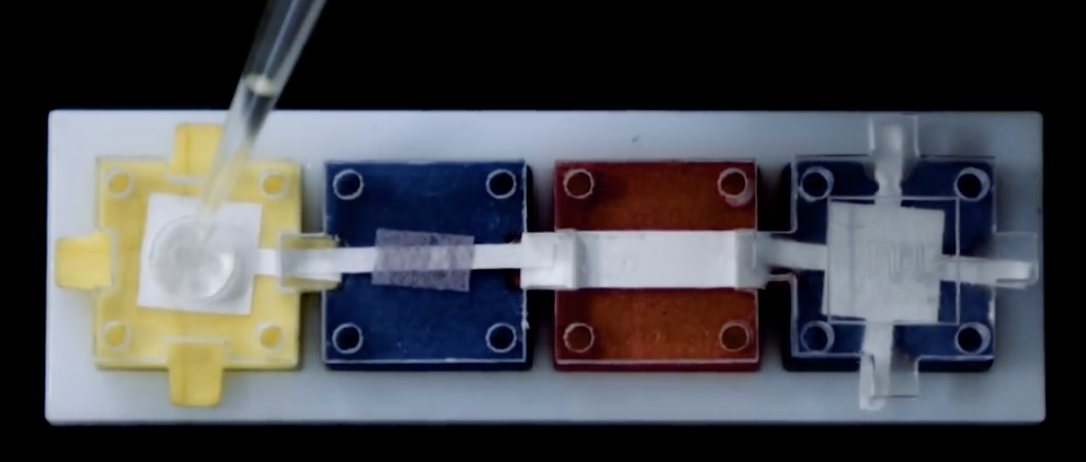MIT’s modular plug-and-play blocks allow for building medical diagnostic devices
May 16, 2018

Tiny 1/2-inch, low-cost “Ampli blocks” can be assembled to create diagnostic devices. The blocks, which simply consist of a tiny sheet of paper or glass fiber sandwiched between a plastic or metal block and a glass cover, snap together to form a complete diagnostic procedure. Some of the blocks contain channels for samples to flow straight through, some have turns, and some can receive a sample from a pipette, or mix multiple reagents (chemicals) together. The blocks are color-coded by function, making it easy to assemble pre-designed devices (the researchers plan to put instructions online). (credit: MIT Little Devices Lab)
Researchers at MIT’s Little Devices Lab have developed a set of modular “plug-and-play” blocks that can be put together in different ways to produce medical diagnostic devices for detecting cancer and infectious diseases such as Zika virus.
The “Ampli blocks” require little expertise to assemble, and can test blood glucose levels in diabetic patients or detect viral infection, for example. They are inexpensive (about 6 U.S. cents for four blocks) and no refrigeration is required, making them particularly important for small, low-resources laboratories in the developing world. Small labs can now create their own libraries of plug-and-play diagnostics to independently treat their own local patient populations.
Customized diagnostics on a modular “biochemical breadboard”
KurzweilAI has previously reported on small, portable diagnostic devices based on chemical reactions that occur on paper strips. But these devices haven’t been widely deployed. That’s mainly because they’re not designed for mass-producing a diagnostic test — especially when a disease doesn’t affect a large number of people, the researchers say.
The Little Devices Lab has created a kit of DIY modular components that can be easily put together to generate exactly what a lab needs. So far, the MIT lab has created about 40 different building blocks that lab workers around the world could easily assemble on their own. This approach is similar to assembling radios and other electronic devices from commercially available electronic “breadboards” in the 1970s, or more recently, creating your own homemade computer gadgets with an Arduino breadboard or a Raspberry Pi computer.

Jose Gomez-Marquez, co-director of MIT’s Little Devices Lab, holds a sheet of tiny diagnostic papers, which can be easily printed and attached to blocks to form diagnostic devices. (credit:Melanie Gonick/MIT)
The reusable blocks can also perform different biochemical functions. Many contain antibodies that can detect a specific molecule in a blood or urine sample. The antibodies are attached to nanoparticles that change color when the target molecule is present, indicating a positive result.
These blocks can be aligned in different ways, allowing the user to create diagnostics based on one reaction or a series of reactions. In one example, the researchers combined blocks that detect three different molecules to create a test for isonicotinic acid, which can reveal whether tuberculosis patients are taking their medication.
The researchers also showed that these blocks can outperform previous versions of paper diagnostic devices in some cases. For example, they found that they could run a sample back and forth over a test strip multiple times, enhancing the signal. This could make it easier to get reliable results from urine and saliva samples, which are usually more dilute than blood samples, but are easier to obtain from patients.
Getting the technology into the hands of small labs and non-experts
The MIT team is now working on tests for human papilloma virus, malaria, and Lyme disease, among others. They are also working on blocks that can synthesize useful compounds, including drugs, and even on blocks that incorporate electrical components such as LEDs.
The ultimate goal is to get the technology into the hands of small labs (and non-experts) in both industrialized and developing countries, so they can create their own diagnostics. The MIT team has already sent Ampli-block kits to labs in Chile and Nicaragua, where they have been used to develop devices to monitor patient adherence to TB treatment and to test for a genetic variant that makes malaria more difficult to treat.
The MIT researchers are now investigating large-scale manufacturing techniques. They hope to launch a company to manufacture and distribute the kits around the world. They’re also opening up the platform to other researchers.
Reference: Advanced Healthcare Materials May 16, 2018. Source: MIT May 16, 2018.
